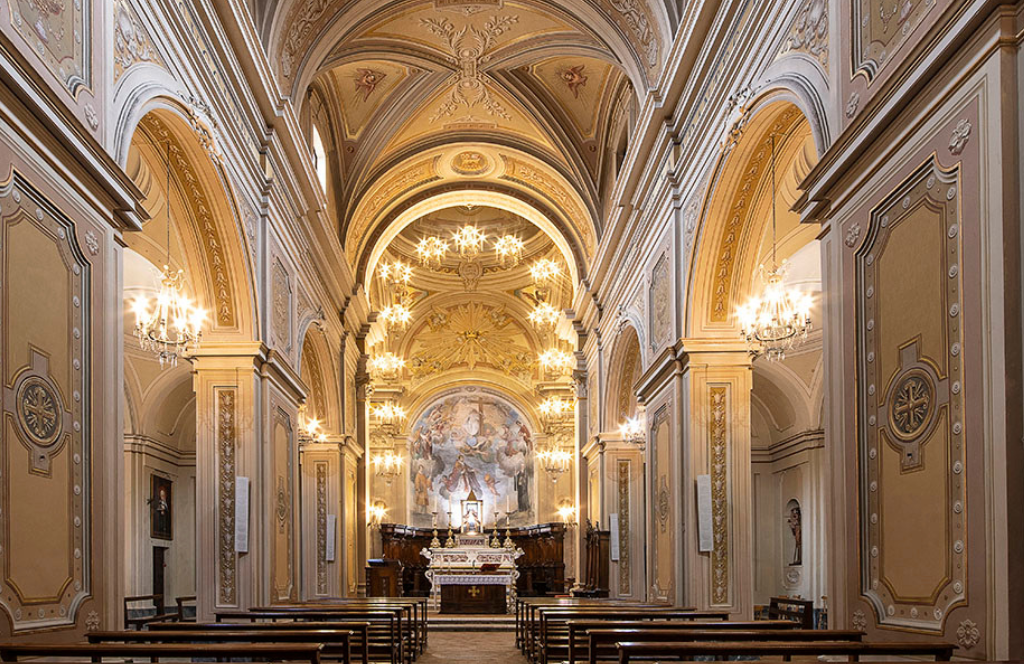
The Basilica of Saint Erasmus. A Memorable Masterpiece of Art and Spirituality
Located just a short distance from Porta Romana, along Via Garibaldi in Veroli, the Basilica of Saint Erasmus stands as a magnificent jewel in the medieval context of the town. Its charm and historical significance attract many faithful visitors and enthusiasts of medieval art history.
History of the Basilica of Saint Erasmus
According to written records, the building originated from an existing oratory built by Saint Benedict and his disciples during their journey from Subiaco to Montecassino in 529 AD. The construction was funded by Valentiniano, a citizen of Veroli, who later joined monastic life and became the abbot of the San Pancrazio Monastery near the Lateran. The Benedictines remained in Saint Erasmus until the 12th century, when they were replaced by regular canons.
Architecture and Masterpieces
Despite the numerous changes it has undergone over the centuries, the basilica still retains its Romanesque style in the lower part of the façade, the bell tower (originally a Roman tower), and the three imposing apses. The three-arch portico dates back to 1104-1127, while the upper part of the façade was later modified with large eighteenth-century windows designed by the architect Martino. The façade itself is decorated with monstrous figures from whose mouths emerge ornamental motifs, reflecting medieval influences and the mysterious Eastern world.
The decorations, including the monstrous figures and the central frame, are attributed to the Benedictine craftsmen, who were also active in other Abruzzese monuments. The double staircase leading to the portico was added in the 1700s, enhancing the grandeur of the entrance.
Internally, the basilica houses a significant work commissioned by Monsignor Vittorio Giovardi in 1747: a painting by Sebastiano Conca (or possibly T. Kuntze) depicting a meeting in 1170 between Pope Alexander III and Evardo, Bishop of Bamberg, sent by Emperor Frederick Barbarossa, along with sixteen cardinals and representatives of the Lombard League.
In the left nave, there is a painting attributed to an anonymous pupil of Maratta, depicting the Baptism of Jesus. The Chapel of the Sacrament houses a precious gilded silver chalice dating back to the late 14th century, which was the focal point of a Eucharistic Miracle that took place on March 26, 1570, during the Easter celebrations.
Testimonies of the Past
Among the other treasures preserved in the basilica are a bronze encolpion, an 11th-century pectoral cross with figures of the Crucifixion, the Madonna, and various saints, and a 12th-century parchment martyrology. The latter, restored by the Vatican, is a precious testimony of medieval history and is included in the Regesta Chartarum Italiae, compiled by the Italian Historical Institute for the Middle Ages. The Basilica of Saint Erasmus, with its rich history and artistic magnificence, stands as an authentic Romanesque masterpiece that captures the essence of the medieval era in Veroli.
Upon entering the Basilica of Saint Erasmus, one feels enveloped by the grandeur of a millennial heritage that continues to radiate its brilliance. This architectural wonder is not just a monument of stone but a protagonist in the events that have shaped the community of Veroli over the centuries.
Through the enchanting interplay of light filtering through the eighteenth-century windows and the mysterious sculptures adorning the façade, we embark on a fascinating journey through medieval legends and Eastern influences, reflecting the depth of a spirituality that has withstood the relentless passage of time.
In the heart of the basilica, among priceless works of art and historically significant artifacts, lies a wealth that goes beyond the material: the legacy of a devoted community and its passionate guardians.
The Basilica of Saint Erasmus is not just a place of worship; it is a reflection of human resilience, a union of art and faith, and a millennial symphony that echoes through the stones and works that compose it.
For more information, visit the Pro Loco of Veroli website.
Enjoy your visit!
